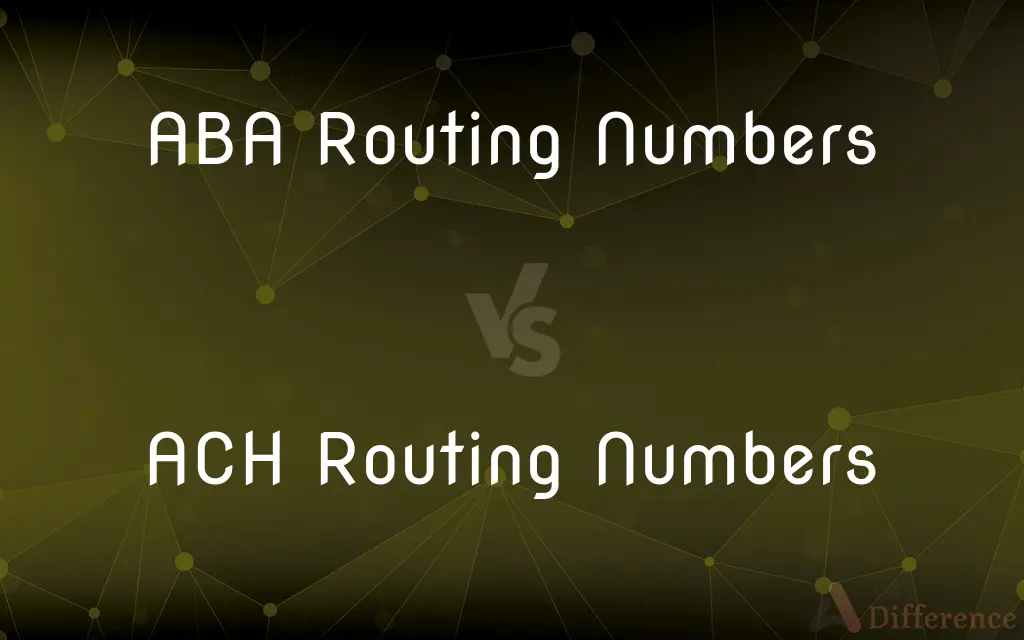ABA Routing Numbers vs. ACH Routing Numbers — What's the Difference?
Edited by Tayyaba Rehman — By Fiza Rafique — Published on November 5, 2023
ABA Routing Numbers identify individual U.S. banks for paper transactions, while ACH Routing Numbers are used for electronic transfers. Both help route payments correctly but have different purposes.

Difference Between ABA Routing Numbers and ACH Routing Numbers
Table of Contents
ADVERTISEMENT
Key Differences
ABA Routing Numbers, officially known as American Bankers Association routing numbers, are nine-digit codes assigned to U.S. banks and are used to identify them for check processing. Each bank has its unique ABA number, ensuring the check gets to the right place. On the other hand, ACH Routing Numbers refer to those used for electronic transactions, like direct deposits and automatic payments.
When looking at checks, one can find the ABA Routing Numbers printed at the bottom, typically on the left side. These numbers help in sorting and shipping the checks back to the drawer's account. In contrast, ACH Routing Numbers are used for electronic transfers; for instance, if one gets paid via direct deposit or pays a credit card bill online.
In some cases, banks have a separate ABA Routing Number for paper transactions and another for electronic ones. This distinction ensures transactions are streamlined and are processed efficiently. So, while they may have the same number, some banks differentiate between ABA and ACH numbers for better transaction handling.
The ABA Routing Numbers have been in existence since 1910, introduced by the American Bankers Association. This has been a standard for ensuring proper bank identification. However, with the rise of electronic banking, ACH Routing Numbers came into play to manage the volume and efficiency of electronic transactions.
Essentially, while both ABA Routing Numbers and ACH Routing Numbers serve to identify banks during transactions, their primary difference lies in their usage — the former mainly for paper checks and the latter for electronic transfers.
ADVERTISEMENT
Comparison Chart
Purpose
Used for paper-based transactions, like checks.
Used for electronic transactions, such as direct deposits.
Appearance on Checks
Found on the bottom left side of checks.
May not be present on checks; used electronically.
Existence
Introduced in 1910 by the American Bankers Association.
Emerged with the rise of electronic banking.
Unique Numbers
Some banks have a separate ABA number for paper and electronic transactions.
Some banks have a distinct ACH number from their ABA number.
Identification
Nine-digit code to identify banks for check processing.
Nine-digit code to identify banks for electronic fund transfers.
Compare with Definitions
ABA Routing Numbers
A nine-digit identification code assigned to U.S. banks for paper transactions.
Ensure you have the correct ABA Routing Numbers before writing a check.
ACH Routing Numbers
A system used to route electronic transactions to the appropriate bank.
Double-check your ACH Routing Numbers before setting up an automatic debit.
ABA Routing Numbers
Codes that ensure checks are sent to the right bank for payment.
When setting up check payments, provide your ABA Routing Numbers for accuracy.
ACH Routing Numbers
Codes specifically designed for electronic banking operations.
My employer requested my ACH Routing Numbers for salary direct deposit.
ABA Routing Numbers
Numeric codes that help route checks to the appropriate banking institution.
You can find the ABA Routing Numbers at the bottom of your checks.
ACH Routing Numbers
Digital transaction identifiers differing from traditional ABA numbers.
For wire transfers, ensure you've got the accurate ACH Routing Numbers.
ABA Routing Numbers
The traditional system of bank identification for paper-based transactions.
If you're not doing an electronic transfer, you'll need the ABA Routing Numbers.
ACH Routing Numbers
Numeric identifiers used for electronic fund transfers in the U.S.
For direct deposits, you'll need to provide your ACH Routing Numbers.
ABA Routing Numbers
Identifiers introduced by the American Bankers Association in 1910 for check processing.
Different banks have unique ABA Routing Numbers for transaction identification.
ACH Routing Numbers
Nine-digit codes helping in the processing of electronic transactions.
Make sure to use the correct ACH Routing Numbers for online bill payments.
Common Curiosities
Can a bank have different ABA and ACH numbers?
Yes, some banks use distinct numbers for paper and electronic transactions.
What are ABA Routing Numbers used for?
ABA Routing Numbers are primarily used for paper-based transactions like checks.
Do I need ACH Routing Numbers for direct deposits?
Yes, ACH Routing Numbers are typically required for setting up direct deposits.
How are ACH Routing Numbers different from ABA Routing Numbers?
ACH Routing Numbers are specifically for electronic transfers, while ABA Routing Numbers are for paper transactions.
How long have ABA Routing Numbers been in existence?
ABA Routing Numbers were introduced in 1910 by the American Bankers Association.
Is it safe to share my ACH Routing Numbers?
Yes, but only with trusted entities like employers for direct deposit.
Where can I find my bank's ABA Routing Numbers?
ABA Routing Numbers are usually located at the bottom left of your checks.
Why were ACH Routing Numbers introduced?
ACH Routing Numbers emerged with the growth of electronic banking to efficiently handle electronic transfers.
Are ACH Routing Numbers present on checks?
Not always. While some banks use the same number, others have separate ABA and ACH numbers.
How many digits are there in ABA and ACH Routing Numbers?
Both ABA and ACH Routing Numbers are nine-digit codes.
How can I confirm my bank's ACH Routing Numbers?
You can check your bank's website or contact their customer service for confirmation.
What do ABA Routing Numbers specifically identify?
ABA Routing Numbers identify U.S. banks for paper-based transactions like checks.
Can I use ABA Routing Numbers for electronic transfers?
Generally, no. Electronic transfers typically require ACH Routing Numbers.
Do all banks have separate ABA and ACH numbers?
Not all. Some banks use the same number for both types of transactions.
Are ABA Routing Numbers unique to each bank?
Yes, each bank has its unique ABA Routing Number for identification.
Share Your Discovery

Previous Comparison
The Muppets vs. Sesame Street
Next Comparison
East Coast Oysters vs. West Coast OystersAuthor Spotlight
Written by
Fiza RafiqueFiza Rafique is a skilled content writer at AskDifference.com, where she meticulously refines and enhances written pieces. Drawing from her vast editorial expertise, Fiza ensures clarity, accuracy, and precision in every article. Passionate about language, she continually seeks to elevate the quality of content for readers worldwide.
Edited by
Tayyaba RehmanTayyaba Rehman is a distinguished writer, currently serving as a primary contributor to askdifference.com. As a researcher in semantics and etymology, Tayyaba's passion for the complexity of languages and their distinctions has found a perfect home on the platform. Tayyaba delves into the intricacies of language, distinguishing between commonly confused words and phrases, thereby providing clarity for readers worldwide.











































